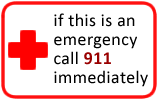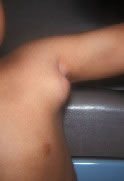Lymph Nodes - Swollen
Lymph Nodes - Swollen
Does this describe your child's symptoms? |
Click image for more info |
Definition
Causes
Return to School
|
If not, see these topics
|
When to Call Your Doctor |
Call Your Doctor Now (night or day) If |
|
|
|
Call Your Doctor Within 24 Hours (between 9 am and 4 pm) If |
|
|
|
Call Your Doctor During Weekday Office Hours If |
|
|
|
Parent Care at Home If |
|
|
HOME CARE ADVICE FOR SMALL LYMPH NODES |
Reassurance for Normal Nodes: If you have discovered a pea-sized or bean-sized node (smaller than ½ inch or 12 mm), this is a normal lymph node. Don't look for lymph nodes, because you can always find some (especially in the neck and groin).
Reassurance for Swollen Nodes from a Viral Infection: Viral throat infections and colds can cause lymph nodes in the neck to double in size. Slight enlargement and mild tenderness means the lymph node is fighting the infection and doing a good job.
Fever or Pain Medicine: Give acetaminophen (e.g., Tylenol) or ibuprofen as needed for fever above 102° F (39° C) or pain. Otherwise no treatment is needed.
Avoid Squeezing: Don't squeeze lymph nodes because it may keep them from shrinking back to normal size. Tell your child not to fidget with them.
Contagiousness: Swollen lymph nodes alone are not contagious. If the swollen nodes are associated with a cold, sore throat or other infection, your child can return to school after the fever is gone and your child feels well enough to participate in normal activities.
Expected Course: After the infection is gone, the nodes slowly return to normal size over 2 to 4 weeks. However, they won't ever completely disappear.
Call Your Doctor If:
Node enlarges to over 1 inch (2.5 cm) in size
Node over ½ inch (12 mm) persists over 1 month
Your child becomes worse
And remember, contact your doctor if your child develops any of the "Call Your Doctor" symptoms.
Updated:
March 22, 2017




